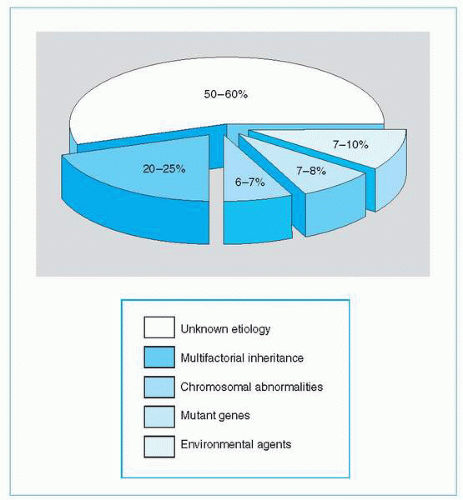Genetic Disorders
A genetic disease is caused by abnormalities in an individual’s genetic material (genome).
There are four different types of genetic disorders: (1) single-gene, (2) multifactorial, (3) chromosomal, and (4) mitochondrial.
Sickle cell anemia is an example of a single-gene disorder.
Spina bifida is an example of a multifactorial genetic disorder.
Down syndrome is an example of a chromosomal genetic disorder.
Mitochondrial genetic disorders are rare, and can cause multiple life threatening deficits.
Genes reproduce themselves, but as cells divide, the genes do not remain identical. Specialization occurs, so that different kinds of cells are formed at different locations. In the process, mistakes sometimes happen, leading to defects and disorders that affect normal function (Figure 17-1). A genetic disorder is a disease caused by abnormalities in an individual’s genetic material (genome). Four types of genetic disorders are distinguished: (1) single gene, (2) multifactorial, (3) chromosomal, and (4) mitochondrial.
According to the Centers for Disease Control and Prevention (CDC; Kung, Hoyert, Xu, & Murphy, 2007), the three leading causes of infant mortality—congenital malformations, disorders related to short gestation and low birthweight, and sudden infant death syndrome—accounted for approximately 43% of all infant deaths in the United States.
Single-gene disorders are caused by changes or mutations that occur in the DNA sequence of one recessive gene. Two carriers of a recessive gene have a one in four chance of passing on the disorder to their child.
This section discusses the incidence and characteristics of some single-gene disorders that are inherited. Certain disorders, such as Tay-Sachs disease and sickle-cell anemia, are found among specific populations because of intermarriage.
Tay-Sachs Disease
Jews of Eastern European origin are struck hardest by Tay-Sachs disease, which causes death by the age of 4 or 5 years. At birth, the afflicted children appear normal, but development slows by the age of 6 months, and mental and motor deterioration begin. Approximately 1 in every 25 to 30 Jews of Eastern European origin carries the defective gene, which is recessive—increasing the likelihood of passing on the disorder. Tay-Sachs disease occurs when a gene fails to produce an enzyme that breaks down fatty materials in the brain and nervous system. As a result, fat accumulates and destroys nerve cells, causing loss of coordination, blindness, and finally death.
Sickle-Cell Anemia
Sickle-cell anemia mainly affects people of African descent. It appeared thousands of years ago in equatorial Africa, and increased resistance to malaria among carriers of the defective gene. Estimates are that 10% of the African American population in the United States carry the sickle-cell trait. In patients with sickle-cell anemia, the red blood cells are distorted and angular, not round. Because of the cells’ shape, they encounter difficulty in passing through the blood vessels.
The cells tend to pile up and clump, producing oxygen starvation accompanied by considerable pain. The body then acts to eliminate these cells, and anemia results.
The cells tend to pile up and clump, producing oxygen starvation accompanied by considerable pain. The body then acts to eliminate these cells, and anemia results.
 Figure 17-1 Sources of Genetic Defects
Stay updated, free articles. Join our Telegram channel
Full access? Get Clinical Tree
 Get Clinical Tree app for offline access
Get Clinical Tree app for offline access
Get Clinical Tree app for offline access

|


